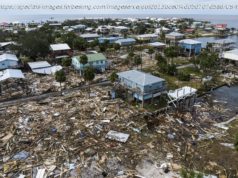Limiting the damage requires rapid, radical change — but such changes have happened before.
Is there any hope on climate change, or are we just screwed?
I hear this question all the time. When people find out what I do for a living, it is generally the first thing they ask. I never have a straightforward or satisfying answer, so I usually dodge it, but in recent years it has come up more and more often.
So let’s tackle it head on. In this post, I will lay out the case for pessimism and the case for (cautious) optimism, pivoting off a new series of papers from leading climate economists.
First, though, let’s talk about the question itself, which contains a number of dubious assumptions, and see if we can hone it into something more concrete and answerable.
When people ask about hope, I don’t think they are after an objective assessment of the odds. Hope not a prediction that things will go well. It’s not a forecast or an expectation. But then, what is it exactly?
It’s less intellectual than emotional; it’s a feeling. As I wrote at length in this old post, the feeling people are groping for is fellowship. People can face even overwhelming odds with good spirits if they feel part of a community dedicated to a common purpose. What’s terrible is not facing great threat and long odds — what’s terrible is facing them alone. Happily, those working to address climate change are not alone. There are more people involved and more avenues for engagement every day. There’s plenty of fellowship to be found.
More importantly, though, when it comes to climate change, “Is there hope?” is just a malformed question. It mistakes the nature of the problem.
The atmosphere is steadily warming. Things are going to get worse for humanity the more it warms. (To be technical about it, there are a few high-latitude regions that may see improved agricultural production or more temperate weather in the short- to mid-term, but in the long haul, the net negative global changes will swamp those temporary effects.)
The international community has agreed, most recently in the Paris climate accord, to try to limit the rise in global average temperature to no more than 2 degrees Celsius above preindustrial levels, with efforts to keep it to 1.5 degrees.
But there’s nothing magic about 2 degrees. It doesn’t mark a line between not-screwed and screwed.
In a sense, we’re already screwed, at least to some extent. The climate is already changing and it’s already taking a measurable toll. Lots more change is “baked in” by recent and current emissions. One way or another, when it comes to the effects of climate change, we’re in for worse.
But we have some choice in how screwed we are, and that choice will remain open to us no matter how hot it gets. Even if temperature rise exceeds 2 degrees, the basic structure of the challenge will remain the same. It will still be warming. It will still get worse for humanity the more it warms. Two degrees will be bad, but three would be worse, four worse than that, and five worse still.
Indeed, if we cross 2 degrees, the need for sustainability becomes more urgent, not less. At that point, we will be flirting with non-trivial tail risks of species-threatening — or at least civilization-threatening — effects.
In sum: humanity faces the urgent imperative to reduce greenhouse gas emissions, then eliminate them, and then go “net carbon negative,” i.e., absorb and sequester more carbon from the atmosphere than it emits. It will face that imperative for several generations to come, no matter what the temperature is.
Yes, it’s going to get worse, but nobody gets to give up hope or stop fighting. Sorry.
Rather than just rejecting the question, though, let’s give it a little more specificity, so we can discuss some real answers. Let’s ask: What are the reasonable odds that the current international regime, the one that will likely be in charge for the next dozen crucial years, will reduce global carbon emissions enough to hit the 2 degree target?
Remember, the answer to that question will not tell us whether there is hope, or whether we’re screwed. But it will tell us a great deal about what we’re capable of, whether we can restrain and channel our collective development in a sustainable direction.
With all that said, let’s get to the papers.
The argument for why we’re unlikely to hit the 2 degree target is not difficult to construct. As the latest IPCC report shows, for any hope of hitting 2 degrees, global emissions must peak and begin rapidly falling within the next dozen years. And they must continue rapidly falling until humanity goes net carbon negative sometime around mid-century or shortly thereafter. That means developed countries must go negative earlier, to allow for a slower and more difficult shift in developing countries.
Accomplishing that would require immediate, bold, sustained, coordinated action. And, well… look around. Look at how things are going. Look at who is running things. Look at the established economic regimes of the last half-century.
As Enno Schröder and Servaas Storm of Delft University write in their blunt and unsettling recent paper, “the required degree and speed with which we have to decarbonize our economies and improve energy efficiency are quite difficult to imagine within the context of our present socioeconomic system.”
The paper is called “ The Road to ‘Hothouse Earth’ is Paved with Good Intentions ” and it is an unsparing reality check. Understanding the argument requires a brief bit of background.
The dominant climate-economic models used to generate scenarios showing how to hit the 2 degree target produce a few key common outcomes. One is that they require an extraordinary amount of energy efficiency. The bulk of the reduction in demand for fossil fuels through 2040 or so, in most successful 2 degree scenarios, is accomplished by reduction in overall energy demand. It is only around 2040 that displacement of fossil fuel energy by zero-carbon energy takes over as the dominant driver of fossil fuel reductions.
How can energy demand fall while economies grow? The great hope (and lately, great hype) is for “decoupling.”
For centuries now, the growth of economies has been tightly coupled with rising energy demand and rising greenhouse gas emissions — a one-to-one correlation, more or less. In recent years, however, several countries have seen their economies grow faster than their emissions. From this somewhat scant evidence, many analysts have concluded that modern economies are “decoupling” GDP and emissions and will eventually sever the connection completely. (Schröder and Storm run through numerous examples of this kind of optimism in their paper.)
The premise of many 2 degree scenarios is that global economies will continue growing but, thanks to the magic of decoupling, carbon intensity — the ratio of carbon emitted per unit of economic output — will rapidly fall and thus so will emissions.
In fact, it’s worth noting that the vast majority of scenarios used by climate policymakers take continued economic growth as an unquestioned premise.






